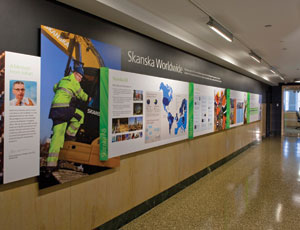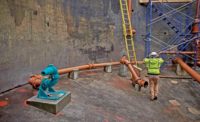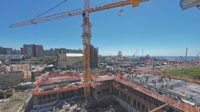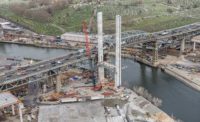The Empire State Building was a marvel when it debuted as the world’s tallest building in 1931. Built in 18 months, the 102-story building kicked off a race for urban construction heights that continues today.

It’s only fitting that a recent $4.6 million fit-out in the building may set the benchmark for what it costs, what it takes, and how much can be saved in the long haul by creating a LEED CI Platinum office in an existing building, much less a landmarked skyscraper. That’s because the 32nd floor is not just home for Skanska USA’s New York office – it’s also meant as a showcase for high-end yet achievable sustainability.
“There are a lot of clients that say, ‘I’d love to build green, but it costs too much,’” says Steve Pressler, executive vice president and area general manager of Skanska New York. “But we have kept meticulous records to show them that we could build it for not much more than a regular class A space, to prove to people that in dollars and cents they will save more in the longer term.”
Skanska decided to pursue the top LEED status from the United States Green Building Council even before it picked the tower for its new home last year, moving over from Madison Avenue. The construction company had lined up its design team early to hash through the LEED checklist, and it became clear any existing space would do, Pressler says.
But the Empire State still offered several advantages. “Its original design was inherently green, thanks to how it relied on daylight and natural ventilation,” Pressler says. It also helped that the building’s owner, W&M Properties, became a booster.
The proof is in the finished product – a 24,400-sq-ft space yielding 44 LEED points, more than enough for Platinum on the 57-point scale. Pressler says the construction effort clocked in at $210,000 more than regular Class A office construction, or a “Platinum premium” of 4.7%. But the net present value of savings from 46% lower projected energy costs over the 15-year lease adds up to $556,436. After accounting for the premium and a green projects grant the team won, Skanska gains net savings of $368,380 over the lease term. And that’s using conservative energy savings estimates, Pressler says.
Skanska is already logging energy savings over its prior 15,500-sq-ft space, which housed only two-thirds of the current 80 staffers, he adds.
Pressler says the marketplace still shows “interest but hesitancy” about green construction, in some cases because of completed projects that have come up short in energy savings. He says most cases involve owners not properly using their green building systems.
Hitting high sustainability goals was of utmost importance for Skanska in order to prove the value of sustainability to clients, says Rick Cook, partner at Cook + Fox, an architecture firm whose own offices became the first LEED CI Platinum project in New York several years ago. He says the key is to maximize advantages you have and to stay committed.
“You try to harvest the best qualities of the original space, and only bring healthy materials inside, and apply the...





Post a comment to this article
Report Abusive Comment